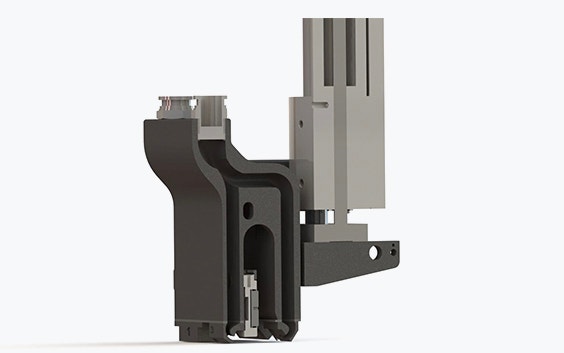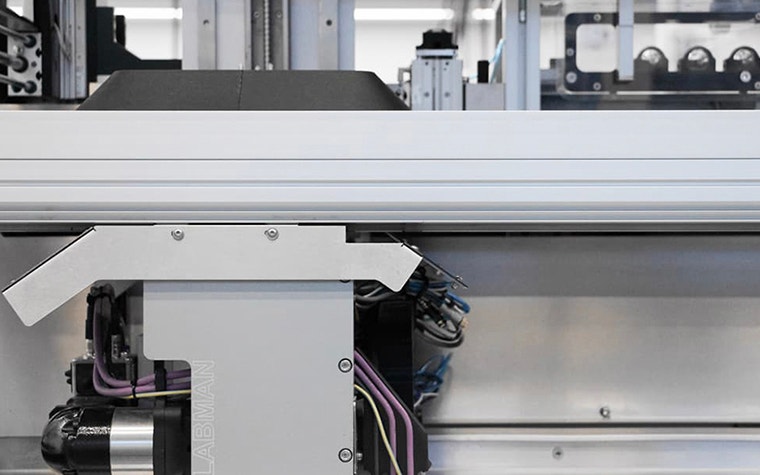CASE STUDY
‘Normalizing New’: How 3DP Has Become Business as Usual for Labman Automation

Labman Automation has been at the forefront of designing custom laboratory automation products and solutions for over 40 years, and counts prestigious research institutions and major manufacturers among its clients. Renowned for its focus on innovation, the company is frequently called in to solve complex automated process puzzles. And increasingly it’s using 3D printing to do it.
Working with Materialise to make 3DP part of its everyday toolkit has transformed Labman’s processes and service offering. As well as helping the UK-based business push boundaries with design, 3DP has helped Labman save its most precious commodity: time. By simplifying prototype and end-part creation for complex components, Labman has been able to shave days off its design process, more easily adapt to changing briefs, and deliver replacement parts quickly, all while allowing the business to put its own stamp on the robots it creates.
3DP adoption, driven by design
Established in 1979, Labman designs and manufactures tailor-made laboratory robotic solutions for liquid handling, powder feeding, sample preparation, weighing and labelling, testing samples, wet chemistry and many other applications. The sectors it serves are varied but there are common challenges the team face day-in, day-out. It’s these challenges that first led Labman to explore 3D printing.
“3D-printed parts may end up accounting for less than 5% of a total system but when you can solve [a complex problem], it can end up being one of the most important design aspects. ”
— Sean Devereux, Mechanical Design Engineer at Labman
“We regularly have to fit complex and precise processes into confined, compact areas”, explains Sean Devereux, Mechanical Design Engineer at Labman. “Often, that means coming up with weird and wonderful fixtures and fittings that make the impossible, possible.
“For instance, we had one project where samples had to be held in a particular way while allowing water to be shot at them. The space restrictions and precision angles required for water application meant we were facing a real head-scratcher in terms of meeting the customer’s exact requirements. Using traditional techniques, it might very well have been impossible. But with 3D printing, we could embed the actual gripper into another part and create internal channels to direct the water in precisely the right way. 3D-printed parts may end up accounting for less than 5% of a total system but when you can solve issues like this, it can end up being one of the most important design aspects.”
Convinced by creative convenience
What the team hadn’t expected was how easy it would be to adopt 3DP and that this would in turn deliver significant benefits. Labman uses Materialise’s OnSite service, an online solution that enables users to submit their CAD file, receive a quote and then have a 3D-printed part created and delivered in a matter of days.
““Thanks to Materialise OnSite, going from initial idea to final proof of concept is far quicker, which ultimately is more profitable for us and most cost-effective for our customers.” ”
— Tom Gale, a Project Engineer at Labman
“It’s perfect for us”, says Tom Gale, a Project Engineer at Labman. “We simply submit our designs with exact specifications and receive the part back exactly as intended. Everything we create for customers is bespoke, and a large percentage of a project lies in the design process — developing a blade with the right twist profile to mix a powder in precisely the right way, or a gripper that enables a sample to be treated but not tainted — it takes a lot of time to test our ideas and find the right answer.
“Before we adopted 3DP, building some of these parts, testing them, tweaking the design and building them again; it could take an incredibly long time. Now we can quickly and cost-effectively print multiple prototype iterations to find exactly the right solution. Thanks to Materialise OnSite, going from initial idea to final proof of concept is far quicker, which ultimately is more profitable for us and most cost-effective for our customers.”
Project-by-project adoption
Labman’s design process involves a detailed User Requirement Specification (URS) analysis, whereby exact functionality and performance details are mapped out and key goals are broken down — dispensing a liquid in a certain way, channeling airflow over samples/materials — before the team embarks on an intense design study to develop the right solution.
“With every new project or adaptation, we discover more. That’s how it goes, you try something new, you learn something new, you share that information — so at the same time as pushing boundaries you are making these new techniques part of the everyday process.”
“We quickly began to see URS requirements that really leaned themselves to 3D printing, not just in terms of general suitability — I mean specific functionality common to the types of clients we work with”, explains Tom. “For example, we often need to keep cabling in place to maximize space in tight spots, while also ensuring those cables are protected against power or liquid ingress. This used to mean developing awkwardly shaped brackets that were both time-intensive and expensive to make. With 3D printing, this is not the case.
“With every new project or adaptation, we discover more. That’s how it goes, you try something new, you learn something new, and you share that information — so at the same time as pushing boundaries, you are making these new techniques part of the everyday process. It’s worked so well that we’ve essentially been able to develop ‘trademark’ 3D-printed elements that we are known for, such as our Mobile Dispensing Units (MDUs), parts we can then easily manufacture in small series.”
Supporting systems as shop windows
For inventor Rob Hodgson, another important factor that has supported the company’s rapid adoption of 3DP has been customer reaction. “In addition to 3D printing parts for prototyping/feasibility testing, the quality of the materials means we are able to use printed components on our finished production machines”, says Rob.
“With a material like PA-AF (Aluminum Filled), for example, you can tap it or put in inserts, so it’s perfect for making complex metal components that can also easily be replaced if needed. And because we can use 3DP in this way, we are also able to improve the aesthetics of the solutions we design. For example, many of the parts we are able to create, say in PA-AF or stainless steel, negate the need for awkward, unattractive solutions and messy cable areas. They just look much better.


“Remember, these are often multi-million-pound machines; systems that reflect major capital investment. First and foremost they have to do a job, but for many of our Blue Chip clients, how these robots look is really important. Recently we worked on a state-of-the-art robot for Liverpool University’s Materials Innovation Factory — a groundbreaking facility available to major companies all around the world. The solution we’ve provided, which features many bespoke 3D-printed components, is representing the university — it has to look the part.”
‘Normalizing new’ down to picking the right partner
Having the ability to blend in-house design expertise with outsourced production through Materialise’s OnSite service has, for Labman, helped them quickly realize a number of key benefits. As Rob explains, “What we’ve been able to do is normalize something new by finding a way of working that suits us, and the right 3DP partner to help get us moving quickly.
“We’ve then been able to build on this foundation to flex our capabilities. For example, while we have the in-house knowledge to give exact 3D print spec and processing briefs through OnSite, we also know we can also call on the design team at Materialise to help us with specific projects that may require more 3DP experience, for instance where we might have tolerance issues for certain material combinations.
“On the flip side to that, we’ve also introduced our own 3D printer that we can also turn to when needed. Essentially the options we now have in our toolbox means we always have a solution to suit specific project needs.”
Share on:
This case study in a few words
Machinery & equipment
Materialise OnSite
Metal 3D printing
PA-AF
Design optimization
Faster lead times
Finishing quality
